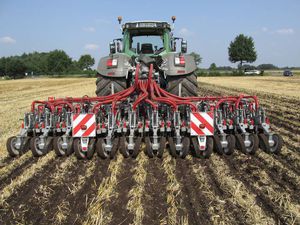
- Farm Machinery
- Tillage
- Rotor strip-tiller
- Hugo Vogelsang Maschinenbau GmbH
Rotor strip-tiller XTill ProTerra8-rowfor wheat
Add to favorites
Compare this product
Characteristics
- Type
- rotor
- Number of rows
- 8-row
- Other characteristics
- for wheat
- Width
6 m
(19'08" )
Description
The Strip Till method combines the advantages of no-till and conventional soil cultivation approaches. Multiple work steps are combined into a single step. Plowing, deep tillage, seed bed conditioning and liquid manure incorporation are accomplished in a single pass, saving time and money.
But this results in more than just economic benefits for the farm. This method brings several other important advantages in terms of plant cultivation as well. Due to the fact that only part of the surface is tilled in strips, the untilled parts remains covered with plant remnants. This protects against soil erosion, harmful compaction, and also evaporation. With this type of tillage, the lane is located on the untilled section. This not only makes the ground better to drive on, it also keeps the soil's pore system intact for water infiltration. The soil warms up very quickly in the tilled strips, creating optimal germination and growth conditions for crops. Liquid manure is spread at the same time as the ground is tilled and is deposited precisely where plants need nutrients: around their roots. Few emissions are produced in this process. This precise deposition reduces the need for mineral fertilizers.
Catalogs
No catalogs are available for this product.
See all of Hugo Vogelsang Maschinenbau GmbH‘s catalogsOther Hugo Vogelsang Maschinenbau GmbH products
Strip Till
*Prices are pre-tax. They exclude delivery charges and customs duties and do not include additional charges for installation or activation options. Prices are indicative only and may vary by country, with changes to the cost of raw materials and exchange rates.


